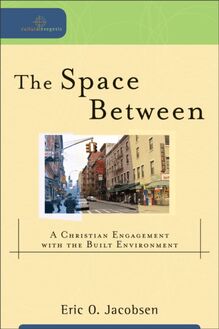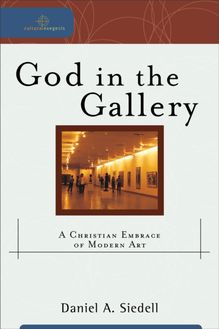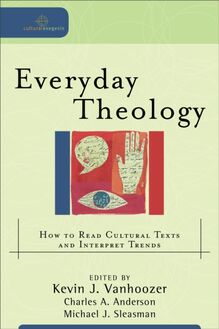Space Between (Cultural Exegesis) , livre ebook
176
pages
English
Ebooks
2012
Vous pourrez modifier la taille du texte de cet ouvrage
Obtenez un accès à la bibliothèque pour le consulter en ligne En savoir plus
Découvre YouScribe en t'inscrivant gratuitement
Découvre YouScribe en t'inscrivant gratuitement
176
pages
English
Ebooks
2012
Vous pourrez modifier la taille du texte de cet ouvrage
Obtenez un accès à la bibliothèque pour le consulter en ligne En savoir plus
Publié par
Date de parution
01 août 2012
Nombre de lectures
1
EAN13
9781441238696
Langue
English
Poids de l'ouvrage
2 Mo
Publié par
Date de parution
01 août 2012
Nombre de lectures
1
EAN13
9781441238696
Langue
English
Poids de l'ouvrage
2 Mo
William A. Dyrness and Robert K. Johnston, series editors
The Cultural Exegesis series is designed to complement the Engaging Culture series by providing methodological and foundational studies that address the way to engage culture theologically. Each volume works within a specific cultural discipline, illustrating and embodying the theory behind cultural engagement. By providing the appropriate tools, these books equip the reader to engage and interpret the surrounding culture responsibly.
© 2012 by Eric O. Jacobsen
Published by Baker Academic
a division of Baker Publishing Group
P.O. Box 6287, Grand Rapids, MI 49516-6287
www.bakeracademic.com
Ebook edition created 2012
Ebook corrections 11.09.2017
All rights reserved. No part of this publication may be reproduced, stored in a retrieval system, or transmitted in any form or by any means—for example, electronic, photocopy, recording—without the prior written permission of the publisher. The only exception is brief quotations in printed reviews.
Library of Congress Cataloging-in-Publication Data is on file at the Library of Congress, Washington, DC.
ISBN 978-1-4412-3869-6
Unless otherwise indicated, Scripture quotations are from the New Revised Standard Version of the Bible, copyright © 1989, by the Division of Christian Education of the National Council of the Churches of Christ in the United States of America. Used by permission. All rights reserved.
Scripture quotations marked KJV are from the King James Version of the Bible.
“In The Space Between , Eric O. Jacobsen sets himself two goals: to get us to attend to urban space—the space between the buildings in a city or village—and to explain why Christians in particular should care about the quality of urban space. He succeeds admirably on both counts; cities will look different to you once you have read this book. Along the way he also introduces us to some of the most recent writings on urban space, and he offers a compelling explanation of why the urban space of our present-day American cities came to be as it is and why we should be dissatisfied with it. It’s a fine contribution to an extremely important topic that has been neglected for too long by too many.”
— Nicholas Wolterstorff , Noah Porter Professor Emeritus of Philosophical Theology, Yale University; senior fellow, Institute for Advanced Studies in Culture, University of Virginia
“Eric Jacobsen’s The Space Between is a seasoned Presbyterian pastor’s account of the reciprocal relationship between urban form and communal life. As Pope Benedict XVI reminds us, ‘Life in society must be considered first and foremost as a spiritual reality.’ And Jacobsen, working from a Christ-centered perspective emphasizing both justice and generosity, articulates not only for pastors and laypeople but also for neo-traditional urbanists what religious communities have to gain from traditional towns and neighborhoods, and what they have to give. Highly recommended.”
— Philip Bess , director of graduate studies, University of Notre Dame School of Architecture; author, Till We Have Built Jerusalem
“Jacobsen’s book awakens us from our Gnostic slumbers. It reminds us that as embodied beings, we not only move through space but inhabit particular places. And it asks us how we ought to make and dwell in the built environment to the glory of God. The Space Between takes us on an eye-opening tour of the places that both shape and reflect us. Readers may never look at their homes, neighborhoods, towns, and churches in the same way again. This is an important first step in reclaiming the locality of the local church.”
— Kevin J. Vanhoozer , research professor of systematic theology, Trinity Evangelical Divinity School
“ The Space Between presses the argument for the importance of the built environment to the mission of the church, deepening the challenge before us of partnering in the emerging kingdom of God. Jacobsen demonstrates that the church’s intellectuals are bringing to bear on the world of ideas the insights of Christian theology and our own intuitive experiences of the places we inhabit. Given the scale of what we have built—from the sprawling exurbs to the troubled cities—there is much to say and do. The Space Between opens our imaginations to see that the places we make can and should be sustainable realizations of beauty and places of justice.”
— Christopher C. Miller , assistant chair for graduate programs, department of architecture, Judson University
“Jesus urges us to love our neighbor, but in many modern cities we have destroyed our neighborhoods, making it much more difficult to know who our neighbors are, let alone love them. In this compelling and beautifully written book Eric Jacobsen tells us how that has happened, why it matters, and what we should be doing about it. This book calls us to think again, and more theologically, about the way our built environment shapes our life together. It invites us to consider how, through the shaping of our neighborhoods, we may participate more faithfully in the coming kingdom of God.”
— Murray Rae , professor of theology, University of Otago
Dedicated to Conrad W. Jacobsen 1936–2011
Contents
Cover
Series Page
Title Page
Copyright Page
Endorsements
Dedication
List of Illustrations
Acknowledgments 9
Introducing the Built Environment 11
Part I: Orientation 29
1. Who Are You? 33
2. Where Are You? 55
3. What Are You? 79
4. When Are You? 103
Part II: Participation 131
5. Family 135
6. Politics 157
7. Church 183
Part III: Engagement 207
8. The Sustainable Environment 213
9. Loving Place 239
Conclusion: A Geography of Rest 271
Notes 279
Index 289
Back Cover
Illustrations
Fig. 0.1. Enacted Space
Fig. 0.2. From Garden to City
Fig. 0.3. Two Kingdoms
Fig. 0.4. Unified Kingdom
Fig. 0.5. The Most Advanced Civilization in the World
Fig. 0.6. Between the Garden and the City (II)
Fig. 1.1. Curb Radii
Fig. 1.2. Distance and Intimacy
Fig. 1.3. Connectivity
Fig. 1.4. The Automobile Exurb
Fig. 1.5. Pedestrian Shed
Fig. 2.1. The Days of Creation
Fig. 2.2. Carved Space vs. Objects On A Tabletop
Fig. 2.3. Legoland
Fig. 2.4. Aspect Ratio
Fig. 2.5. Leaking Space
Fig. 2.6. Outdoor Hallway
Fig. 2.7. Outdoor Room
Fig. 2.8. Streetwall
Fig. 2.9. Monumental Building
Fig. 2.10. Monuments and Monumental Buildings on Axis
Fig. 2.11. Fabric Buildings
Fig. 2.12. Saturated and Minimal Thresholds
Fig. 4.1. Four-Chapter Gospel
Fig. 4.2. Garden to City (Part III)
Fig. 5.1. Typical Housing Types
Fig. 5.2 Terrace to Villa
Fig. 6.1 Le Corbusier’s Plan Voisin
Fig. 6.2. The Demolition of Pruitt-Igoe
Fig. 6.3. Garden City
Fig. 6.4. Two Visions of Urban Life
Fig. 7.1. Typical Church Types
Fig. 8.1. Classic Conflicts in Development
Fig. 9.1. Regulating Lines
Fig. 10.1. A Place for Rest
Acknowledgments
When I first began thinking and writing about theology and the built environment more than ten years ago, it felt like I was the only one snooping around in the space between the buildings looking for signs of the kingdom. I have since discovered that I am not alone. In fact there is not room to name all of the kindred spirits I have discovered along the way. There are, however, a number of people who have been especially helpful in shaping and clarifying my thinking in this important area—Howard Ahmanson, Jim Belcher, Phillip Bess, Jonathan and Nate Bradford, Randy Frazee, Griff Gatewood, David Gobel, Tim Gorringe, David Gruesel, Charles Matthews, Ken Meyers, Christopher Miller, Stefanos Polyzoides, Murray Rae, Jill Shook, Clinton Stockwell, Gideon Strauss, Kathryn Streeter, James Van Hemert, Mike Watkins, Summer Wilkes, Cory Wilson, and Nicolas Wolterstorff.
I also want to thank Bill Dyrness and Richard Mouw who helped with the arduous task of backfilling my theological foundation after I had already started building the house. Lee Hardy has been invaluable to this project. He not only provided the illustrations and many photos for this volume, but also has been the intellectual version of the friend you don’t have to clean the house for. Lee has seen most of my work long before it was ready for public viewing and has helped put my ideas in their best possible light. And speaking of light, this project would never have seen the light of day without Bob Hosack who suggested it to me over doughnuts at the AAR, Lisa Williams who never fails to astound me with her patient care and attention to detail, and Lance Kagey who helped with the photo editing. And, of course, I want to thank all the folks at Baker Academic who believed that this subject was worth a second book; the First Presbyerian Church of Tacoma for giving me a couple of months to finish the project; and for Liz, Kate, Peter, Emma, and Abraham for allowing me to spend too much time on this project that should have been spent with them.
Introducing the Built Environment
But the L ORD God called to the man, and said to him, “Where are you? (Genesis 3:9)
Begin Where You Are
Where are you ? As you read these words, you are doing so somewhere. This may seem obvious, but bear with me a moment. You may think that the question is hardly worth asking. But since “Where are you?” was the very first recorded question that God asked, let’s run with it a bit.
Wherever you happen to be as you read this book, you are most likely in a place that we can call a built environment. So take a second to look around before reading further. Who thought this space through, and what can you discern about their values as you interact with it?
Did they value community very much? How can you tell? Were they thinking of you as a person, as a resource user, or as a consumer?
Think about how you got from the last place you were to where you are now. Was the experience of getting from there to here a meaningful part of your day, or was it a meaningless necessity to get you from point A to point B? Who deci






